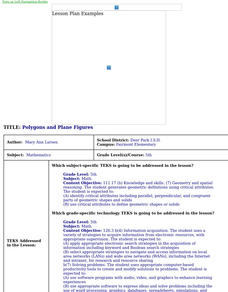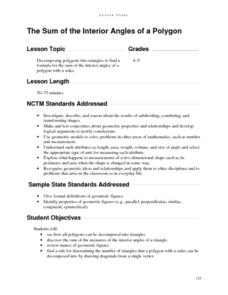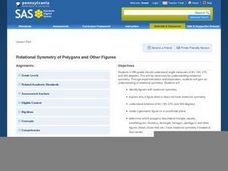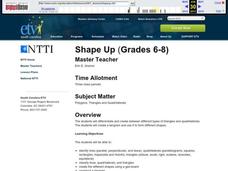Curated OER
Finding Polygons in Cubist Art
Fourth graders explore geometric properties and relationships in a two-dimensional work of art. They first search for and identify polygons in a Cubist painting and then use polygons to create their own Cubist portrait of a classmate.
Curated OER
The Very Busy Spider
Youngsters explore visual arts by participating in a geometry identification activity. They read the book The Very Busy Spider and identify the techniques spiders use to create webs. Have you ever noticed that their webs are geometric...
Curated OER
Tantalizing Tangrams
Students identify polygons and develop spatial and fractional relationships and geometric concepts by using ancient Chinese puzzle of tangrams. They develop an appreciation of the folktale by identifying its elements and then writing...
Curated OER
Classifying Geometric Figures
Fourth graders recognize and classify geometric figures. In this geometry lesson, 4th graders read the books Shape Up and The Greedy Triangle and prepare a short report on the shapes mentioned in the text. Students compare the...
Curated OER
Polygon Necklaces
Students explore geometry by creating jewelry in class. In this polygons lesson, students identify different shapes and characteristics while creating polygon figures from construction paper. Students utilize a multitude of shapes...
Curated OER
Problem Solving Using Power Polygons
Students investigate geometric shapes by creating figures on a plane. In this polygon lesson, students complete a worksheet based on the angles in a power polygon. Students identify the different types of polygons and define their...
Curated OER
Polygons and Plane Figures
Students choose a polygon to define and describe, and use Power Point and the Internet to present their polygon.
Improving Measurement and Geometry in Elementary Schools
The Sum of the Interior Angles of a Polygon
Junior geometers discover that polygons can be decomposed into triangles and that the number of triangles can be determined by a rule. Note that the Geometer’s Sketchpad® software is required to carry out all components of this...
Curated OER
Polygons, Parallelograms, Quadrilaterals- Oh My!!!
Young scholars demonstrate their comprehension of shapes and their properties. They work in small groups. Students review the following terms: property, polygon, quadrilateral, and parallelogram. They read Shape Up! Fun With Triangles...
Pennsylvania Department of Education
Rotational Symmetry of Polygons and Other Figures
Students explore geometry by participating in a shape rotation experiment. For this symmetry lesson, students identify the term symmetry and a list of other geometry vocabulary. Students analyze shapes as they are turned 90 degrees and...
Curated OER
Shape Up
Middle schoolers explore differents types of triangles and quadriaterals. In this polygon lesson, students model identify and compare two and three dimensional geometric figures. Middle schoolers create tangrams and discover the...
Curated OER
Weave a Wreath
Students employ simple measuring and weaving techniques. Then they experiment with the negative and positive space of a cutout. Students also follow directions to complete a multi-step process that results in an attractive holiday...
Curated OER
Number Prefixes
Young scholars recognize the number prefixes used throughout the English language. They identify the shapes and the prefixes that are associated with them.
Curated OER
Exploring Geometric Figures
Tenth graders explore mathematics by participating in hands-on daily activities. Learners identify a list of different shapes and classify them by shape, size, sides and vertices. They utilize tangrams and geometric pieces to gain...
Curated OER
Traditional American Indian Lodges
Young scholars explore the mathematical properties of traditional American Indian lodges. They examine the effect of increasing sides of a polygon, calculate the surface area of prisms and cylinders, and construct a classroom size...
Curated OER
Quandaries, Quagmires, and Quadrilaterals
Students classify, flip, slide, and turn a quantity of quadrilaterals.
Curated OER
Surface Area with Polydrons
Students explore measurements by analyzing geometric shapes. In this surface area lesson, students identify the terms volume, weight, perimeter and area in order to find the requested measurements of specific polygons. Students utilize...
Curated OER
"School Shape Scavenger Hunt"
Students, in groups, venture onto the schoolground on a scavenger hunt for shapes. They are given tasks: recorder, team leader, presenter, reporter, and behavior guidelines and a time limit. They search the school for shapes found in...
Curated OER
Writing Takes Shape!
Students read The Greedy Triangle and discuss geometric solids. In this geometry lesson, students list the geo-solids in the world and create a graphic organizer to show where geo-solids exist.
Curated OER
A Honey of a Hexagon
Students explore how bees make honey and why the hexagon is the best basic pattern for the honeycomb through the use of a video and hands-on activities with honeycombs and geometric shapes.
Curated OER
Angles in Art
Students utilize their handheld and the Angles program to create a non-objective artwork. Images created by famous artists who have utilized angles in their art work are examined.




















